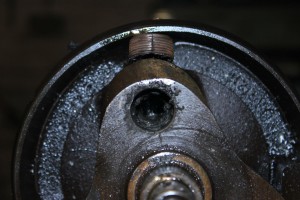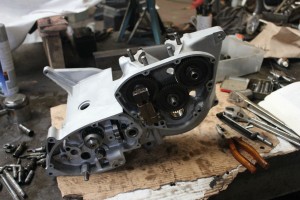Triumph motorcycles seemed to have got everything sorted out when they introduced the 1970 triumph TR6. They are a joy to work on and a particularly good starting point for a novice engine builder, in that they are simple in construction with the unit construction gear box and no fiddly parts. The most awkward part is usually the sludge trap in the crank.
The blanking plug can be drilled with a 3/8 inch hole right through and a tapered metal working chisel can be hammered into the drilled hole and an adjustable spanner turns it. It is guaranteed to work no matter how much staking points there are or how mangled it is. When you have completed this task the sludge tube has to be removed which is very awkward if you do not have the correct tools. If you do not remove the sludge tube you will have to soak it in paraffin and blow all orifices out with high pressure air, this will have to be done several times and then you will end with an acceptable clean usable item but it will not be perfectly clean. Another little bugbear is installing the gearbox internals. Do exactly what the manual say’s and you will not have any troubles even though it looks awkward.
Timing marks on the cam shaft drive gear can be confusing, some gears have three keyways cut into them, do exactly the you manual says for the model and do not get confused by the pictures in the manual as it will no doubt cover several models.
After a rebore the crankshaft assembly should ideally be rebalanced. The cranks when manufactured where never accurately balanced on your first engine strip down even if everything is perfect. It’s worth getting the job done. If you do it, it will make all the diference on the engines life. When restoring a Triumph engine I always try to find out how fussy the client is concerning originality. 70 percent do not care if the cross head screws are replaced with stainless steel socket head screws and as many would like to see the engine cases fettled with a little more finess.
As when they where broken out of there sand casting moulds they were roughly hewn with an angle grinder to get the worst flashings of aluminium off.
Another little thing to look at is the cam followers, The exhaust cam follower stems have a little flat ground on them and a little hole drilled into the flat, these are the exhaust followers, the holes face away from themselves.
Bear in mind I have seen exhaust cam followers mixed up with the inlet ones. Over time in using the engine you will see parts getting damaged notably the cam-shaft lobes and stellited follower faces
Overall the Triumph TR6 is a little power house if maintained properly. Just add oil and as usual on all engines, replenish at the correct intervals.


